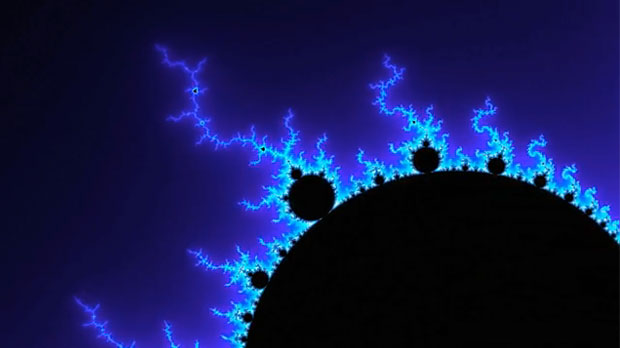Who discovered the Mandelbrot set? This is not a trick question—or a trivial one. The set has been called (in this magazine) “the most complex object in mathematics.” That is debatable, yet it is almost certainly the most famous such object. The infinitely intricate computer-generated image of the set serves as an icon for the burgeoning field of chaos theory and has attracted enormous public attention.
The set is named after Benoit B. Mandelbrot, a mathematician at the IBM Thomas J. Watson Research Center. He is best known for coining the term fractal to describe phenomena (such as coastlines, snowflakes, mountains and trees) whose patterns repeat themselves at smaller and smaller scales. Mandelbrot claims that he and he alone discovered the Mandelbrot set—which has fractal properties—about a decade ago. He refers to its image as his “signature.”
Three other mathematicians have challenged his claim. Two maintain that they independently discovered and described the set at about the same time as Mandelbrot did. A third asserts that his work on the set not only predated Mandelbrot’s efforts but also helped to guide them. These assertions have long circulated in the mathematics community but have only recently surfaced in print.
Mathematicians are not known for priority battles, but Mandelbrot—a self-described “black sheep “—has often bumped heads with colleagues. “Were it not for his personality,” remarks Robert L. Devaney of Boston University, who says he admires Mandelbrot’s work, “there would be no controversy.”
The scientific stakes are also high. Even those who scorn the set’s popularity acknowledge its mathematical significance. Dennis P. Sullivan of the City University of New York calls it a “crucible” for testing ideas about the behavior of dynamical (or nonlinear, or complex, or chaotic) systems. “It is really quite fundamental,” he says.
Part of the charm of the set is that it springs from such a simple equation: z2 + c. The terms z and c are complex numbers, which consist of an imaginary number (a multiple of the square root of –1) combined with a real number. One begins by assigning a fixed value to c, letting z = 0 and calculating the output. One then repeatedly recalculates, or iterates, the equation, substituting each new output for z. Some values of c, when plugged into this iterative function, produce outputs that swiftly soar toward infinity. Other values of c produce outputs that eternally skitter about within a certain boundary. This latter group of c’s, or complex numbers, constitutes the Mandelbrot set.
When plotted on a graph consisting of all complex numbers, the members of the set cluster into a distinctive shape. From afar, it is not much to look at: it has been likened to a tumor-ridden heart, a beetle, a badly burned chicken and a warty figure eight on its side.
A closer look reveals that the borders of the set do not form crisp lines but seem to shimmer like flames. Repeated magnification of the borders plunges one into a bottomless phantasmagoria of baroque imagery. Some forms, such as the basic heartlike shape, keep recurring but always with subtle differences.
Today virtually anyone with a personal computer can “discover” the set. But [in 1979] computers were much less powerful, and few mathematicians associated computers with serious mathematics.
Even Mandelbrot has described his first tentative steps toward the set in 1979 as “mindless fun.” He began using a computer to map out Julia sets, which are generated by plugging complex numbers into iterative functions. The sets’ peculiar properties had been described as early as 1906 by the French mathematician Pierre Fatou. They were named later for Gaston Julia, who successfully claimed that his work on the sets some dozen years later had greater significance than Fatou’s. Mandelbrot, who was born [in 1924] in Poland, had read the work of both men and studied under Julia in the 1940’s.
Mandelbrot’s early computer images served to confirm his suspicion that Julia sets have fractal properties. He says he began producing recognizable pictures of the Mandelbrot set—which in a sense is a generalized version of all Julia sets—in late 1979. Mandelbrot subsequently displayed images of the set and elaborated on its significance in speeches, papers and books. This discovery and his other work in fractals were also celebrated in the media, in numerous books (notably the best-seller Chaos, by former New York Times reporter James Gleick) and in IBM advertisements.
No one denies that Mandelbrot’s pictures and descriptions spurred other mathematicians to study the set. Two prominent examples are John H. Hubbard of Cornell University and Adrien Douady of the University of Paris. In the early 1980’s—in the course of proving that tiny “islands” surrounding the main body of the set are linked to it by infinitesimal filaments—they named the set after Mandelbrot. “Mandelbrot was the first one to produce pictures of it, using a computer, and to start giving a description of it,” Douady wrote in 1986.
Douady now says, however, that he and other mathematicians began to think that Mandelbrot took too much credit for work done by others on the set and in related areas of chaos. “He loves to quote himself,” Douady says, “and he is very reluctant to quote others who aren’t dead.”
[In the fall of 1989] Steven G. Krantz of Washington University aired some of these grievances in the Mathematical Intelligencer, a quarterly journal. The main point of his article was that fractals, computer-generated graphics and other “popular” mathematical phenomena associated with Mandelbrot have contributed little of substance to mathematics, especially in comparison to the publicity they have garnered.
This view—and its opposite, which holds that Mandelbrot’s “popular” work has been a stimulating force in mathematics—had been voiced before. Krantz introduced a new element into the debate, however, by stating that the Mandelbrot set “was not invented by Mandelbrot but occurs explicitly in the literature a couple of years before the term ‘Mandelbrot set’ was coined.” He cited a paper by Robert Brooks and J. Peter Matelski published in the proceedings of a 1978 conference at Stony Brook, N.Y.
Sure enough, the paper contains the famous z2 + c formula and a crude but unmistakable computer printout of the set’s basic image. Brooks and Matelski say they did not actually present the paper at the 1978 conference, but they did circulate it as a preprint in early 1979. Brooks, who is now at the University of California at Los Angeles, also presented the paper at Harvard University in the spring of that year. (Mandelbrot, who held an appointment at Harvard then, says he did not hear Brooks speak and only saw the paper years later.) The paper was not published, however, until early 1981.
In a rebuttal to Krantz’s article, called “Some ‘Facts’ that Evaporate upon Examination,” Mandelbrot noted that he “fully published” on the Mandelbrot set before Brooks and Matelski did. (Mandelbrot’s paper, published in the December 26, 1980, Annals of the New York Academy of Sciences, features a function and image that are variants of those now associated with the Mandelbrot set, which Mandelbrot did not publish until 1982.)
Mandelbrot also suggested that even if Brooks and Matelski’s publication had preceded his, they still could not be considered discoverers of the set, because they did not appreciate its significance. “[They were] close to something that was to prove special, but they gave no thought to the picture,” he wrote.
Brooks retorted in the following issue of the Intelligencer: “I don’t know how he can be so sure of what we gave thought to and what we didn’t.” Brooks says he respects Mandelbrot’s achievements as a popularizer and does not object to the set’s being named after him. “It makes more sense than ‘the thing with the big cardioid,'” he says, recalling how he and Matelski had referred to the set. “I just wish Mandelbrot were a little more gentlemanly.”
Matelski, who works at the Hartford Graduate Center in Connecticut, notes that neither he nor Brooks asked Krantz to credit them with having discovered the Mandelbrot set. (Krantz confirms that another mathematician drew his attention to their paper.) But now that the issue has become public, Matelski says he and Brooks should be acknowledged as co-discoverers with Mandelbrot.
“You don’t have to fully exploit the mineral resources of a continent to discover it,” Matelski was quoted as saying in the Hartford Courant, a newspaper that reported on the dispute in December [1989]. “All you have to do is kneel down and kiss the beach.”
A subtly different claim of precedence has been made by Hubbard, who is now considered one of the world’s experts on the Mandelbrot set. In 1976, he explains, he began using a computer to map out sets of complex numbers generated by an iterative process known as Newton’s method. Hubbard says he did not realize it then, but he had found a different way of generating the Mandelbrot set.
In late 1978 one of Hubbard’s graduate students, Frederick Kochman, approached Mandelbrot at a conference and showed him Hubbard’s pictures. Mandelbrot “didn’t seem very interested,” Kochman recalls. Yet shortly thereafter Mandelbrot wrote a letter to Hubbard inviting him to IBM to discuss his work. In the letter, which Hubbard kept, Mandelbrot wrote: “When sampling the works of Fatou and Julia, I had thought of doing these things myself, but had not mustered the courage. Nevertheless I can claim that I was awaiting your pictures for a long long time.”
Hubbard says he went to IBM early in 1979 and, while there, told Mandelbrot how to program a computer to plot the output of iterative functions. Hubbard concedes that he did not appreciate the full significance of his own images then and that they showed only pieces of the Mandelbrot set. He also admits that Mandelbrot developed a superior method for generating images. Nevertheless, Hubbard says he was and continues to be “outraged” that Mandelbrot did not give him credit in the 1980 paper and later writings. “It was a breach of mathematical ethics,” he asserts.
Mandelbrot recalls seeing “one impressively early drawing of a Julia set” by Hubbard but denies that it contributed to his own discovery. In response to Hubbard and Douady’s charge that he is stingy in granting credit, Mandelbrot says he has also been accused of overcitation. He adds that his failure to cite the early finding of Brooks and Matelski might have spared them “derision” for “their failure to do anything with it.”
What about the suggestion of Hubbard, Matelski and Brooks that the true discoverer of the Mandelbrot set is Fatou, who was the first to define the set and speculate about its properties? Brooks even proposes that “if Fatou had had access to modern computing facilities, he could have and would have drawn pretty much the same pictures that Matelski, Mandelbrot and I did.” Mandelbrot calls such speculation pointless and insists that Fatou’s definition of the Mandelbrot set does not constitute discovery. “Definition counts for nothing,” he says. “You have to say why something is important.”
Other mathematicians familiar with the case are somewhat bemused. “It seems strange to me that there should be such a fuss,” remarks John Milnor of Princeton University. He maintains that neither Brooks and Matelski nor Mandelbrot did anything mathematically important. “Hubbard and Douady are the first ones to really obtain some sharp results,” he says, “and let us know something about the set.”
The dispute over precedence, Milnor suggests, may spring from a clash of different mathematical cultures. “In pure mathematics,” he explains, “there is a tradition of letting others praise your work.” Mandelbrot, he notes, is in applied mathematics.
“Mathematical developments don’t take place single-handedly,” William P. Thurston of Princeton points out, “and it’s pretty common that things are not named after the first person to develop them. The Mandelbrot set follows that pattern.” He suggests, however, that no one would begrudge recognizing Mandelbrot’s achievements if he would reciprocate more himself. “He could be a bit more magnanimous,” Thurston says.
Sullivan, who has also been acclaimed for his studies of the Mandelbrot set, calls himself “sort of a defender of Mandelbrot.” Mandelbrot deserves to have the set named after him, Sullivan says, because his efforts brought the set to the attention of both the public and of the pure-mathematics community.
The fact that it was only “by coincidence” that the set proved later to be mathematically significant, Sullivan says, in no way diminishes Mandelbrot’s achievement. “That’s the wonderful thing about mathematics,” he adds. “Even amateurs can make important contributions.”
So who did discover the Mandelbrot set? Sullivan calls the question meaningless. Perhaps. Sheldon Axler, editor of the Intelligencer, plans to publish a letter pointing out that the Hungarian mathematician F. Riesz reported on work related to the set in 1952 .















